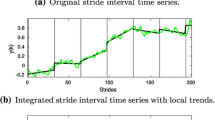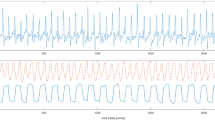Abstract
Stride-to-stride time intervals during human walking are characterised by predictability and statistical persistence quantified by sample entropy (SaEn) and detrended fluctuation analysis (DFA) which indicates a time dependency in the gait pattern. However, neither analyses quantify time dependency in a physical or physiological interpretable time scale. Recently, entropic half-life (ENT½) has been introduced as a measure of the time dependency on an interpretable time scale. A novel measure of time dependency, based on DFA, statistical persistence decay (SPD), was introduced. The present study applied SaEn, DFA, ENT½, and SPD in known theoretical signals (periodic, chaotic, and random) and stride-to-stride time intervals during overground and treadmill walking in healthy subjects. The analyses confirmed known properties of the theoretical signals. There was a significant lower predictability (p = 0.033) and lower statistical persistence (p = 0.012) during treadmill walking compared to overground walking. No significant difference was observed for ENT½ and SPD between walking condition, and they exhibited a low correlation. ENT½ showed that predictability in stride time intervals was halved after 11–14 strides and SPD indicated that the statistical persistency was deteriorated to uncorrelated noise after ~50 strides. This indicated a substantial time memory, where information from previous strides affected the future strides.





Similar content being viewed by others
References
Alkjaer, T., P. C. Raffalt, H. Dalsgaard, E. B. Simonsen, N. C. Petersen, H. Bliddal, and M. Henriksen. Gait variability and motor control in people with knee osteoarthritis. Gait Posture 42:479–484, 2015.
Baltich, J., V. Von Tscharner, P. Zandiyeh, and B. M. Nigg. Quantification and reliability of center of pressure movement during balance tasks of varying difficulty. Gait Posture 40:327–332, 2014.
Bisi, M. C., and R. Stagni. Complexity of human gait pattern at different ages assessed using multiscale entropy: from development to decline. Gait Posture 47:37–42, 2016.
Buzzi, U. H., N. Stergiou, M. J. Kurz, P. A. Hageman, and J. Heidel. Nonlinear dynamics indicates aging affects variability during gait. Clin. Biomech. (Bristol, Avon) 18:435–443, 2003.
Costa, M., C. K. Peng, A. L. Goldberger, and J. M. Hausdorff. Multiscale entropy analysis of human gait dynamics. Physica A 330:53–60, 2003.
Dingwell, J. B., and J. P. Cusumano. Re-interpreting detrended fluctuation analyses of stride-to-stride variability in human walking. Gait Posture 32:348–353, 2010.
Dingwell, J. B., J. John, and J. P. Cusumano. Do humans optimally exploit redundancy to control step variability in walking? PLoS Comput. Biol. 6:e1000856, 2010.
Gates, D. H., J. L. Su, and J. B. Dingwell. Possible biomechanical origins of the long-range correlations in stride intervals of walking. Physica A 380:259–270, 2007.
Georgoulis, A. D., C. Moraiti, S. Ristanis, and N. Stergiou. A novel approach to measure variability in the anterior cruciate ligament deficient knee during walking: the use of the approximate entropy in orthopaedics. J. Clin. Monit. Comput. 20:11–18, 2006.
Goldberger, A. L., L. A. Amaral, J. M. Hausdorff, P. Ivanov, C. K. Peng, and H. E. Stanley. Fractal dynamics in physiology: alterations with disease and aging. Proc. Natl. Acad. Sci. USA 99(Suppl 1):2466–2472, 2002.
Hausdorff, J. M. Gait dynamics in Parkinson’s disease: common and distinct behavior among stride length, gait variability, and fractal-like scaling. Chaos 19:026113, 2009.
Hausdorff, J. M., Y. Ashkenazy, C. K. Peng, P. C. Ivanov, H. E. Stanley, and A. L. Goldberger. When human walking becomes random walking: fractal analysis and modeling of gait rhythm fluctuations. Physica A 302:138–147, 2001.
Hausdorff, J. M., S. L. Mitchell, R. Firtion, C. K. Peng, M. E. Cudkowicz, J. Y. Wei, and A. L. Goldberger. Altered fractal dynamics of gait: reduced stride-interval correlations with aging and Huntington’s disease. J. Appl. Physiol. 82(262–269):1997, 1985.
Hausdorff, J. M., P. L. Purdon, C. K. Peng, Z. Ladin, J. Y. Wei, and A. L. Goldberger. Fractal dynamics of human gait: stability of long-range correlations in stride interval fluctuations. J. Appl. Physiol. 80(1448–1457):1996, 1985.
Hausdorff, J. M., L. Zemany, C. Peng, and A. L. Goldberger. Maturation of gait dynamics: stride-to-stride variability and its temporal organization in children. J. Appl. Physiol. 86(1040–1047):1999, 1985.
Herman, T., N. Giladi, T. Gurevich, and J. M. Hausdorff. Gait instability and fractal dynamics of older adults with a “cautious” gait: why do certain older adults walk fearfully? Gait Posture 21:178–185, 2005.
Jordan, K., J. H. Challis, and K. M. Newell. Walking speed influences on gait cycle variability. Gait Posture 26:128–134, 2007.
Kaipust, J. P., J. M. Huisinga, M. Filipi, and N. Stergiou. Gait variability measures reveal differences between multiple sclerosis patients and healthy controls. Motor. Control 16:229–244, 2012.
Katsavelis, D., M. Mukherjee, L. Decker, and N. Stergiou. The effect of virtual reality on gait variability. Nonlinear Dyn. Psychol. Life Sci. 14:239–256, 2010.
Lee, S. J., and J. Hidler. Biomechanics of overground vs. treadmill walking in healthy individuals. J. Appl. Physiol. 104(747–755):2008, 1985.
Newell, K. M., and D. M. Corcos. Issues in variability and motor control. In: variability and motor control, edited by K. M. Newell, and D. M. Corcos. Champagne, IL: Human Kinetics, 1993.
Newell, K. M., and D. E. Vaillancourt. Dimensional change in motor learning. Hum. Mov. Sci. 20:695–715, 2001.
Nielsen, J. B. How we walk: central control of muscle activity during human walking. Neuroscientist 9:195–204, 2003.
Peng, C. K., S. Havlin, H. E. Stanley, and A. L. Goldberger. Quantification of scaling exponents and crossover phenomena in nonstationary heartbeat time series. Chaos 5:82–87, 1995.
Preatoni, E., J. Hamill, A. J. Harrison, K. Hayes, R. E. Van Emmerik, C. Wilson, and R. Rodano. Movement variability and skills monitoring in sports. Sports Biomech. 12:69–92, 2013.
Raffalt, P. C., M. K. Guul, A. N. Nielsen, S. Puthusserypady, and T. Alkjaer. Economy, movement dynamics, and muscle activity of human walking at different speeds. Sci. Rep. 7:43986, 2017.
Richman, J. S., and J. R. Moorman. Physiological time-series analysis using approximate entropy and sample entropy. Am. J. Physiol. Heart Circ. Physiol. 278:H2039–2049, 2000.
Stergiou, N. Nonlinear Analysis for Human Movement Variability. Boca Raton, FL: CRC Press, 2016.
Stergiou, N., and L. M. Decker. Human movement variability, nonlinear dynamics, and pathology: is there a connection? Hum. Mov. Sci. 30:869–888, 2011.
Stergiou, N., C. Moraiti, G. Giakas, S. Ristanis, and A. D. Georgoulis. The effect of the walking speed on the stability of the anterior cruciate ligament deficient knee. Clin. Biomech. (Bristol, Avon) 19:957–963, 2004.
Terrier, P., and O. Deriaz. Kinematic variability, fractal dynamics and local dynamic stability of treadmill walking. J. Neuroeng. Rehabil. 8:12, 2011.
Terrier, P., V. Turner, and Y. Schutz. GPS analysis of human locomotion: further evidence for long-range correlations in stride-to-stride fluctuations of gait parameters. Hum. Mov. Sci. 24:97–115, 2005.
Yentes, J. M., N. Hunt, K. K. Schmid, J. P. Kaipust, D. McGrath, and N. Stergiou. The appropriate use of approximate entropy and sample entropy with short data sets. Ann. Biomed. Eng. 41:349–365, 2013.
Zandiyeh, P., and V. Von Tscharner. Reshape scale method: a novel multi scale entropic analysis approach. Physica A 392:6265–6272, 2013.
Acknowledgments
Funding for this project was provided by NASA Nebraska EPSCoR and the National Institutes of Health (P20 GM109090).
Author information
Authors and Affiliations
Corresponding author
Additional information
Associate Editor Thurmon E. Lockhart oversaw the review of this article.
Electronic supplementary material
Below is the link to the electronic supplementary material.
Rights and permissions
About this article
Cite this article
Raffalt, P.C., Yentes, J.M. Introducing Statistical Persistence Decay: A Quantification of Stride-to-Stride Time Interval Dependency in Human Gait. Ann Biomed Eng 46, 60–70 (2018). https://doi.org/10.1007/s10439-017-1934-1
Received:
Accepted:
Published:
Issue Date:
DOI: https://doi.org/10.1007/s10439-017-1934-1




